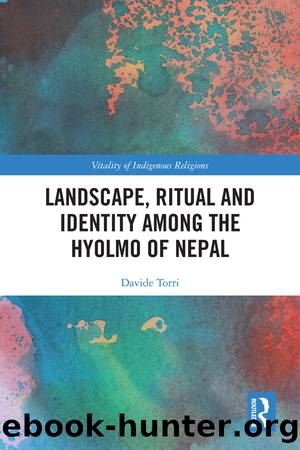Landscape, Ritual and Identity among the Hyolmo of Nepal by Davide Torri

Author:Davide Torri [Torri, Davide]
Language: eng
Format: epub
Tags: Social Science, Indigenous Studies, Anthropology, Cultural & Social, Religion, Ethnic & Tribal
ISBN: 9781317108153
Google: si7YDwAAQBAJ
Publisher: Routledge
Published: 2020-03-20T05:00:49+00:00
Laurence A. Waddell and his colleagues were just recording instances of a different ontology, which, at the popular level, was not revolving around philosophical or theological speculations but, more pragmatically, aimed at solving the daily needs of the communities. At this vernacular level, not the high divinities of the Book were the main interlocutors of the people but the ambiguous hosts of the local deities, the lords of the soil, the owners of the waters, and the restless spirits of the dead. Through possession and mediumship, their presence was made visible in daily life; through oracles, they were making their voice heard; through exorcists and shamans, they were dealt with, appeased or banished.
For the purpose of the present chapter, I will define shamanism as that particular religious expression, centred on the incorporation of non-human entities (mainly helpers) and the ability to travel across different dimensions, including those not totally accessible to the non-initiated in order to perform a series of actions mainly related to negotiate with non-human entities on behalf of its sponsors in order to ensure welfare and well-being on behalf of its sponsors.7 Consequently, I will employ the word âshamanâ to describe the bombo. I will instead use the term âoracleâ and âspirit-mediumsâ to describe other religious specialists well known in the Tibeto-sphere, like for example the lha pa and the dpaâ bo. The latter categories may have close family resemblances to what I previously defined as âshamansâ, but they also differ in some fundamental aspects, i.e. the underlying ideas concerning the possession, the alleged degree of agency retained by the subject during the modified state of consciousness (possession), and the overarching linkage, and subordination, to the Buddhist framework, its establishment and its arch-narratives.
A branch of Nepalese studies has been devoted almost exclusively to investigate Nepalese shamanism, or jhankrism as it has been sometimes called. Among the excellent works written on the subject, I will mention here the entire work of Michael Oppitz (1968, 1981, 1988, 1991, 1997a, 2013); the works of Gregory G. Maskarinec (1995, 1998) on western Nepal; the volumes of Casper J. Miller on faith-healers (1997); Bernard Pignède (1966) and Stan R. Mumford (1989) on the Gurungs; Anne de Sales on the Magar (1991); Martin Gaenszle on the Rai (2000, 2007); Philippe Sagant (2008); the anthology of John T. Hitchcock and Rex L. Jones (1996); Martino Nicoletti (1999, 2006); Diana Riboli (2000) and others. I was, at first, directly inspired by those of Romano Mastromattei (1995, 1999), with whom I undertook my first fieldwork in Nepal. A set of scholars devoted themselves to the consistent study of Tamang shamanic traditions (Höfer 1981; Holmberg 1989; Steinmann 2001; Tautscher 2007; Campbell 2013), and finally, and closer to my own area, Robert R. Desjarlais (1992, 2003, 2016) dealt directly with the Hyolmo. Moreover, even recent works, mainly focusing on the larger framework of ethnic identity, policies and environmental issues have devoted a consistent part of their works to the shamans, their words and their rituals (Campbell 2013; Shneiderman 2015).
Download
This site does not store any files on its server. We only index and link to content provided by other sites. Please contact the content providers to delete copyright contents if any and email us, we'll remove relevant links or contents immediately.
| Baha'i | Cults |
| Demonology & Satanism | Eckankar |
| Egyptian Book of the Dead | Freemasonry |
| Messianic Judaism | Mysticism |
| Scientology | Theism |
| Tribal & Ethnic | Unitarian Universalism |
The Four Agreements by Don Miguel Ruiz(6552)
Breaking Free by Rachel Jeffs(4121)
The Hatha Yoga Pradipika (Translated) by Svatmarama(3189)
120 Days of Sodom by Marquis de Sade(3125)
Member of the Family by Dianne Lake(2284)
The Tao of Physics by Fritjof Capra(2209)
The Psychedelic Gospels: The Secret History of Hallucinogens in Christianity by Jerry B. Brown(2097)
The Road to Jonestown by Jeff Guinn(2002)
Going Clear: Scientology, Hollywood, and the Prison of Belief by Lawrence Wright(1912)
Going Clear by Lawrence Wright(1897)
Uriel's Machine by Christopher Knight(1846)
The Grand Grimoire: The Red Dragon by Author Unknown(1738)
The Gnostic Gospel of St. Thomas by Tau Malachi(1715)
Key to the Sacred Pattern: The Untold Story of Rennes-le-Chateau by Henry Lincoln(1577)
The Malloreon: Book 02 - King of the Murgos by David Eddings(1536)
Waco by David Thibodeau & Leon Whiteson & Aviva Layton(1511)
The New World Order Book by Nick Redfern(1509)
The Secret of the Temple by John Michael Greer(1446)
Animal Speak by Ted Andrews(1427)
